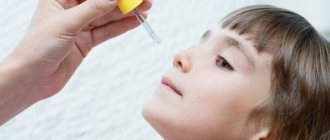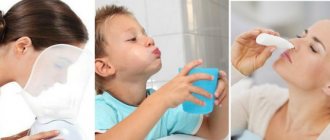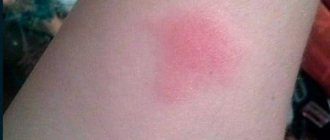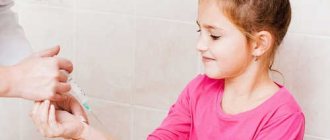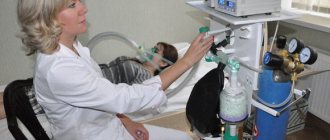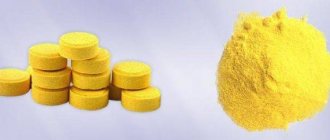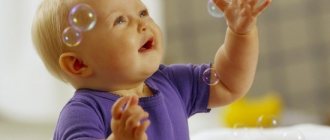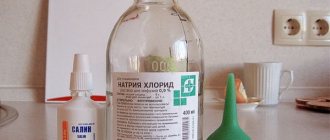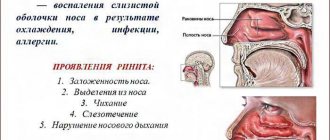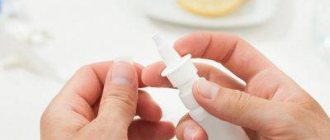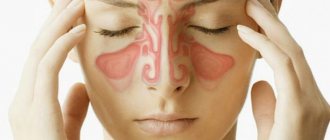This article was checked and edited by Ekaterina Andreevna Kashukh, doctor, mother of two children.
How to quickly and effectively overcome a runny nose or, more simply put, get rid of children's snot? First, you need to understand that a runny nose is, in most cases, a protective reaction of the body to the ingress of cold viruses or allergens. But nasal congestion and runny noses are often necessary to get rid of to prevent more serious consequences of a cold, such as sinusitis or ear infections.
Getting rid of a runny nose
We humidify the air and ventilate the room - this is very important, especially at night. You can make the air more humid using a humidifier or hanging wet towels in the room; be sure to hang such a towel on the radiator. You will see that after these simple measures it will become easier to breathe even without medications.
If you have a runny nose, after discussing this procedure with your doctor, you can try rinsing (moistening) your child’s nose. Many children, especially preschool children, are not able to blow their nose effectively; in this case, these procedures help remove snot from the nasal cavity, as they make the mucus more liquid. Before rinsing or moisturizing, you need to blow your nose as much as possible. Next, directly inject the medicinal solution directly into the nasal cavity.
- To rinse the nose, it is best to use ready-made products with sea or salt water, which are sold at the pharmacy, because they are designed so that a stream of solution enters the child’s nose. Most often used: spray “Salin”, “Aqua Maris” and others.
- It’s easy to prepare the saline solution yourself: 9g (1tsp) table salt per 1l. boiled water.
- This procedure can be done with a regular pipette or a small enema, with caution and after consultation with a doctor.
- The liquid for rinsing the nose should be at room temperature; do not pour in a cold or too hot solution.
- Infusion of aloe juice or other plant juices, as well as irrigating the nose with infusions of chamomile, calendula and other plants can cause an allergic reaction in a child, even shock, in addition, it does not relieve inflammation and does not improve local immunity, as was previously thought, so their use is not recommended.
The frequency of nasal irrigation should be adequate to the amount of discharge, that is, snot; you should not overdo it. So, it is not necessary to drip at night if the child is sleeping peacefully.
It is important to know about the nasal rinsing procedure for children that when liquid is administered under pressure (with a small enema or spray bottle), there is a high probability of water entering the middle ear through the Eustachian tube - this can cause otitis media. That is why you need to consult a doctor before the procedure.
Plants are faithful helpers in the fight against the runny nose.
Herbal infusions and decoctions contain antiseptic, antiviral, antibacterial and antifungal components. Phytoncides—volatile plant substances—help fight infection that affects the nasal mucosa. Therefore, plants play an important role in the treatment of infectious diseases.
A popular folk remedy for the common cold for infants and young children is a weak infusion of chamomile. Measure out 1 tsp. flowers, brew with a cup of boiling water, cool to 36–37°C. Inject 3-5 drops of chamomile infusion into each nostril 3 times a day for the infant. The herb has a moisturizing and anti-inflammatory effect, and the antiseptic effect is less pronounced.
Rinse your nose not only with saline solution and chamomile infusion. Oak bark is often used for colds in children and adults. A child over 3 years old is given a decoction of the bark - an antimicrobial, moisturizing and anti-inflammatory agent. Oak preparations do not have vasoconstrictor properties.
Calendula flowers, thyme and yarrow herbs have a strong antimicrobial, antiseptic and anti-inflammatory effect. An infusion is prepared from these and other plants with similar properties for oral administration. Be sure to take the child’s age into account when choosing herbs. The safest, if the dosages are observed, are chamomile, linden blossom, mint, black currant, raspberries, strawberries (leaves and fruits).
Drops, sprays and ointments for runny nose
I recommend not dripping anything if the runny nose does not bother the child too much, lasts less than 7 days and the child’s nose is not stuffy.
Let's consider what medications for the common cold for children can be offered at the pharmacy:
Oil drops - vegetable oils, Pinosol, etc. They can cause allergic reactions, burning of the nose and are not recommended for use by modern medicine; they are strictly prohibited for up to 2 years.
Vasoconstrictor drugs are prohibited for children under 2 years of age; in children under 5 years of age, their use is possible only after consultation with a doctor; independent purchase at a pharmacy and self-medication with these drugs is unacceptable due to toxicity. Naphthyzine, beloved by many, is especially dangerous in this sense. Poisoning with this vasoconstrictor leads to dizziness, slow heart rate, weakness of the child, and even deaths have been reported with a single use of naphthyzine. Therefore, it is better to forget about naphthyzine for treating children.
If a child has purulent, green snot, pediatricians often prescribe protargol, collargol, the immunomodulator Derinat and interferon instillation. But all these means are not justified - they are expensive and ineffective, and are not recommended anywhere in the world.
Homeopathic remedies for the treatment of a runny nose can also be classified as remedies that will not help in any way against a child’s runny nose, except perhaps to calm the conscience of his parents.
It should be noted that particularly dangerous methods of treating a runny nose are the introduction of garlic in the form of cloves or solutions based on it. Such manipulations will damage the nasal mucosa, even causing severe burns; in addition, there is a risk of garlic particles getting into the nose, and then urgent medical attention will be required.
How to put drops in a child's nose
- It is important that the hands of the person doing the digging are absolutely clean to prevent any infection.
- Now you need to prepare the baby for this procedure, set the child up for a positive perception. Attract them with a game, show by the example of elders that the procedure is safe.
- The next step involves cleansing the nasal passages. Older children can blow their nose on their own. Mom will have to clean the nose of the smallest babies, for example, with a cotton swab.
We recommend reading: “How to clean a child’s nose”
- Now it is important that the little one lies down with his head slightly thrown back.
- Instill the right nostril with the head slightly turned to the left, and the left nostril with the head turned slightly to the right.
- It must be remembered that the tip of the pipette should not come into contact with the baby’s nasal opening.
- Experts advise after instillation to massage the nose using circular movements.
How to carry out the procedure
The following products will suit your child's nose:
- For rinsing, you can use a sea salt solution or saline solution purchased at the pharmacy. They are well suited not only for washing the nasal passages from mucus, but also for softening the crusts that have formed in the nose.
- Vasoconstrictor drops are used if the baby has a stuffy nose. Use for longer than five days is not recommended.
- Drops are immunomodulators. They are recommended to increase the body's immune defense. Used as a prophylactic agent in the fight against viruses.
- Hormone-based drugs. Prescribed in case of allergic rhinitis.
- Antibacterial drops. Most often prescribed in case of a protracted process, accompanied by yellow or green discharge
Thermal procedures (inhalations, steaming feet, baths)
Thermal procedures are often used for home treatment of a runny nose, and for any colds. But warming your feet (steaming your feet) in a bath can only lead to even greater dilation of blood vessels and worsening of a runny nose. In addition, some people use very hot water, which can cause burns.
The same applies to the favorite folk remedy - mustard plasters, which make sense only as a way to make a child lie quietly for a while, but are useless in a medical sense.
Inhalations can be given to children if they have been recommended by a doctor. However, as such, inhaling steam or oils is not only useless, but can burn the sensitive mucous membrane of the little nose.
Be healthy you and your children!
Relieving breathing with a runny nose in children
Since nasal congestion, which is observed with rhinitis, and copious mucus secretion are often non-infectious in nature, it will be useful for parents to know how to ease breathing during a runny nose and cope with the unpleasant manifestations of various types of rhinitis.
General principles of treatment
Effective treatment largely depends on how correct the tactics are chosen and how the basic principles of an integrated approach are observed. The younger the child, the more attention should be paid to the basic recommendations.
Humidity and temperature
An important recommendation from leading pediatricians is to ensure normal humidity parameters and maintain a comfortable temperature in the baby’s room. You can achieve the necessary conditions using simple steps:
Compliance with these recommendations will facilitate the treatment of a runny nose and reduce the risk of recurrence of rhinitis, in addition, it will create optimal conditions for the formation of strong immunity.
Cleansing the nasal cavity
Mucus that accumulates excessively in the nasal cavity requires timely removal. This will help avoid the formation of dry crusts, and snot will cause less discomfort.
The easiest way to remove snot is to blow your nose. For adults this is an absolutely natural and simple process, but a child needs to be taught to do it correctly.
This method is relevant for children who are old enough to master the process of removing mucus on their own. For infants, a different method is suitable. There are special aspirators on sale that allow you to safely and quickly remove excess accumulated mucus and facilitate nasal breathing.
Diet and drinking regimen
The next important basic principle should be drawing up and maintaining a drinking and proper nutrition regimen.
You need to give your child food often, in small portions. This is especially true for a newborn, since he cannot yet communicate his thirst and suffers the most from a lack of water.
Suitable drinks include juices, still mineral water, fruit drinks, herbal teas and compotes. Infants who have not yet been introduced to complementary foods are given only clean drinking water.
Signs that your baby is not getting enough fluids include frequent licking of his lips.
In infants, feeding habits during a runny nose are associated with the fact that difficulty in nasal breathing deprives them of the ability to simultaneously breastfeed or drink from a bottle. Trying to breathe while feeding can cause short-term apnea, and the discomfort will lead to refusal to eat, which will lead to weight loss.
To make the feeding process easier for babies, it is recommended to replace the usual method of eating with feeding from a spoon. The diet of older children should be enriched with fresh fruits and vegetables.
So, directing all your efforts to fight the runny nose, you need to:
As part of the recommendation for changing the diet and drinking regime, it is also important that introducing new products into the usual diet is extremely undesirable. Possible allergic reactions will reduce all efforts to zero and will do more harm than good.
Treatments
Traditional preparations
Ready-made or self-prepared composition can be used in two ways:
Instillation and rinsing with saline solution is an effective way to overcome rhinitis at home using traditional methods. However, you can use drugs instead, for example, Aqua Maris.
Some sources mention hydrogen peroxide for rinsing the nose. Considering the aggressiveness of the solution and the possible burn of the mucous membrane, it is not recommended to use peroxide independently as a rinsing agent.
Children over 1 year old can use nasal drops or sprays to help relieve nasal congestion. The most popular drugs are NoSol, Pinosol, Naphthyzin, Vibrocil, Nazol, Polydexa, Otrivin and others.
Folk remedies
The most common traditional medicine methods for combating nasal congestion in a child:
All the products in this group are really effective in combating the runny nose, but given the high risk of allergic reactions, as well as the difficulty of selecting an individual dosage, they should be used wisely.
Physiotherapeutic
The use of natural physical factors, created at home or with the help of modern physiotherapy devices, will help expand the range of measures to combat the runny nose.
The methods presented are absolutely safe and do not require any special skills.
https://elaxsir.ru/lekarstva/dlya-nosa/kak-oblegchit-rebenku-dyxanie-pri-nasmorke.html
How to clear your nasal passages
In the first months of life, babies do not yet know how to breathe through their mouths, and a runny nose causes severe discomfort; the child becomes capricious and eats poorly.
To avoid this, it is necessary to clean the baby’s nasal passages from accumulated mucus. It is also important to do this before putting drops into the baby’s nose, so that they have a better effect.
Many kids don’t like cleaning their nose, but this is not a reason to postpone the procedure until later.
In order for it to pass as quickly as possible, you need to prepare everything you need in advance.
Sterile cotton wool. You can also use cotton pads. Saline solution. You can buy it at any pharmacy or prepare it yourself. Instead, you can purchase Aquamaris or other nasal cleaners approved for use in newborns. Vaseline oil. Rubber bulb or children's nasal aspirator.
Before carrying out the procedure, you need to wash your hands with soap to avoid introducing an infection into the baby’s nasal passages.
It is best if someone helps you, since the baby’s head needs to be fixed so that he does not twist it, and you do not accidentally damage the nasal passage.
It is necessary to drip the newborn's nose with saline using a pipette, 1-2 drops into each nostril. It will help soften dried crusts and help in cleaning thick nozzles.
Small flagella are made from cotton wool; they are used if the baby’s nose is not very stuffy and you need to remove dried snot from the nasal passage. To soften them, the flagellum can be dipped in Vaseline oil. You should not use a large amount of oil, since when the baby inhales, some of the oil may enter the lungs and cause complications.
If a child has a severe runny nose, an aspirator is used to remove accumulated mucus.
Treatment of a runny nose in a child: appropriate to the situation
To help a child get rid of a runny nose, you can use different methods - it all depends, by and large, on two conditions: the age of the child and the “quality” of his snot. Let's consider all possible situations:
- 1 If the baby is tiny (a newborn or an infant under one year old who does not yet know how to blow his nose on his own), and the snot is liquid , the easiest way is to use a special aspirator, or any other device for sucking out liquids, of which there are dozens of types in any pharmacy these days. In this case, no special medications (without a doctor’s prescription) are needed. By and large, here we are talking more about a caring procedure than a therapeutic one.
- 2 If the baby is tiny (that is, one who does not yet know how to blow his nose on his own), and the snot is thick , then you need to either use vasoconstrictor drops (indication: lack of nasal breathing), or periodically instill a saline solution into the child’s nose, which will gradually transform the thick snot - into liquid. Your task is to collect this liquid with an aspirator without delay.
Please note: sprays and aerosols cannot be used for babies under one year of age! Only drops. This is due to the fact that when spraying a spray into the nose of a newborn or infant, there is a risk of creating dangerous pressure in his ear canal and damaging his hearing.
- 3 If a child is already able to blow his nose and has that same runny nose that flows “in three streams,” blow his nose more often. But according to the rules! When you bring a napkin or handkerchief to your baby’s nose and command “Blow!”, under no circumstances should you pinch his nose with this handkerchief too tightly. Otherwise, you yourself create a situation in which snot “flies” at high speed into the sinuses or into the ear canal. By the way, 85% of all childhood sinusitis and otitis begin this way. How to blow your nose correctly? Pinch each nostril alternately.
- 4 If a child is quite capable of blowing his nose (from a year and older), but cannot do this because the nose is “clogged,” use the same saline solution. But at this age, this drug can already be used in the form of a spray/aerosol. The saline solution will not only make thick mucus more liquid, but will also move it from the front of the nose to the back. From where this liquid will safely “float away” into the esophagus.
Relieving breathing with a runny nose in children
Since nasal congestion, which is observed with rhinitis, and copious mucus secretion are often non-infectious in nature, it will be useful for parents to know how to ease breathing during a runny nose and cope with the unpleasant manifestations of various types of rhinitis.
General principles of treatment
Effective treatment largely depends on how correct the tactics are chosen and how the basic principles of an integrated approach are observed. The younger the child, the more attention should be paid to the basic recommendations.
Humidity and temperature
An important recommendation from leading pediatricians is to ensure normal humidity parameters and maintain a comfortable temperature in the baby’s room. You can achieve the necessary conditions using simple steps:
Compliance with these recommendations will facilitate the treatment of a runny nose and reduce the risk of recurrence of rhinitis, in addition, it will create optimal conditions for the formation of strong immunity.
Cleansing the nasal cavity
Mucus that accumulates excessively in the nasal cavity requires timely removal. This will help avoid the formation of dry crusts, and snot will cause less discomfort.
The easiest way to remove snot is to blow your nose. For adults this is an absolutely natural and simple process, but a child needs to be taught to do it correctly.
This method is relevant for children who are old enough to master the process of removing mucus on their own. For infants, a different method is suitable. There are special aspirators on sale that allow you to safely and quickly remove excess accumulated mucus and facilitate nasal breathing.
Diet and drinking regimen
The next important basic principle should be drawing up and maintaining a drinking and proper nutrition regimen.
You need to give your child food often, in small portions. This is especially true for a newborn, since he cannot yet communicate his thirst and suffers the most from a lack of water.
Suitable drinks include juices, still mineral water, fruit drinks, herbal teas and compotes. Infants who have not yet been introduced to complementary foods are given only clean drinking water.
Signs that your baby is not getting enough fluids include frequent licking of his lips.
In infants, feeding habits during a runny nose are associated with the fact that difficulty in nasal breathing deprives them of the ability to simultaneously breastfeed or drink from a bottle. Trying to breathe while feeding can cause short-term apnea, and the discomfort will lead to refusal to eat, which will lead to weight loss.
To make the feeding process easier for babies, it is recommended to replace the usual method of eating with feeding from a spoon. The diet of older children should be enriched with fresh fruits and vegetables.
So, directing all your efforts to fight the runny nose, you need to:
As part of the recommendation for changing the diet and drinking regime, it is also important that introducing new products into the usual diet is extremely undesirable. Possible allergic reactions will reduce all efforts to zero and will do more harm than good.
Treatments
Traditional preparations
Ready-made or self-prepared composition can be used in two ways:
Instillation and rinsing with saline solution is an effective way to overcome rhinitis at home using traditional methods. However, you can use drugs instead, for example, Aqua Maris.
Some sources mention hydrogen peroxide for rinsing the nose. Considering the aggressiveness of the solution and the possible burn of the mucous membrane, it is not recommended to use peroxide independently as a rinsing agent.
Children over 1 year old can use nasal drops or sprays to help relieve nasal congestion. The most popular drugs are NoSol, Pinosol, Naphthyzin, Vibrocil, Nazol, Polydexa, Otrivin and others.
Folk remedies
The most common traditional medicine methods for combating nasal congestion in a child:
All the products in this group are really effective in combating the runny nose, but given the high risk of allergic reactions, as well as the difficulty of selecting an individual dosage, they should be used wisely.
Physiotherapeutic
The use of natural physical factors, created at home or with the help of modern physiotherapy devices, will help expand the range of measures to combat the runny nose.
The methods presented are absolutely safe and do not require any special skills.
https://elaxsir.ru/lekarstva/dlya-nosa/kak-oblegchit-rebenku-dyxanie-pri-nasmorke.html
Important Rules and Requirements
In order for the procedure to be successful, and for the instillation of drops to become a therapeutic and not a crippling manipulation, a number of requirements must be met. Of course, you should not start the nasal drop procedure with dirty hands - the risk of introducing additional infection or bacteria into the nose increases significantly. Wash your hands with soap and water before putting drops into your child's nose.
It is imperative to prepare the child for this manipulation. Naturally, we are not talking about grown-up children, but about babies, for whom such treatment is akin to torture. It is recommended to try to distract the baby - with conversations, games or something else. If the child is serious and understanding enough, you can try to explain to him the importance of the procedure.
It is recommended to clean the nose first so that the drops fall directly on the mucous membrane. If they get on the mucus, you will have to wait either too long for the effect or not at all. Often for these purposes, young mothers use cotton wool soaked in water. There is another option for preparing the nose for instillation - you need to use special drops and sprays with sea water. They will wash away all excess from the nasal mucosa and will enhance the therapeutic effect of the drugs.
When lowering the pipette into your nose, try not to let it touch the walls
When lowering the pipette into your nose, try not to let it touch the walls. It’s so easy to literally tear the delicate mucous membrane of the nose. And an additional infection can penetrate through the scratches, and the recovery process will be greatly delayed in this case.
The drops you will use should be warm. They must be removed from the refrigerator in advance. If they do not imply storage outside cold conditions, you should slightly warm the bottle between your palms before dripping. This is necessary so that too cold drops do not cause vasospasm.
How to put nose drops correctly
For infants, the nose is buried in a lying position. If the child is very active or very capricious, then you can place him half-sitting on your lap and tilt his head back slightly.
According to the instructions, the required number of drops is taken into the pipette. In order to instill drops into the left nostril, the baby’s head must be tilted to the right and vice versa.
After the product is instilled, you need to hold the child in a lying position for a while so that the droplets flow evenly down the nasal passages.
What can you put in your nose?
Drops should be prescribed by a specialist, since different drops are prescribed for different types of runny nose.
To bury a child's nose, use:
- Various rinsing solutions. As a rule, they are based on sea salt. At the pharmacy you can buy sea water, saline solution, Aquamaris and other products.
- Antibiotic drops . They are prescribed if a runny nose does not go away for a long time, the mucus is thick yellow-green in color.
- Vasoconstrictor drops. They fight the runny nose very effectively, but they should not be taken for more than 4 days due to possible addiction.
- Hormonal drops are usually used for allergic rhinitis.
- Immunomodulatory drops are used to prevent influenza and ARVI.
It should be borne in mind that many products according to the instructions must be stored in the refrigerator, but taking them cold is prohibited. In this case, there is no need to heat the entire bottle.
. The required amount of content is poured into a heated spoon or heated in a water bath.
After instillation, to achieve a greater effect, you should massage the wings of the nose.
Important! Drops in the form of sprays are prohibited for use in infants due to the risk of otitis media and other complications.
Features of the procedure
These procedures have a number of their own characteristics:
- In order to reduce your baby's stress , you should distract him in every possible way with rattles, songs, or whatever he likes.
- Drops should be at room temperature . In addition, they must be measured with a dosed pipette, so as not to accidentally drop in more drops and cause an overdose.
- The procedure must be carried out regularly , because the baby does not yet know how to blow his nose and mucus flows down the throat. This can provoke infection and the development of disease.
- Because the dropper is inserted into the nostril , any drops must be used individually and should not be given to other people.
- To prevent the product from spilling out , after instillation, the nostril must be pressed against the nasal septum for a couple of seconds.
What not to do:
- You cannot replace cotton swabs with cotton swabs, because the latter can cause injury to the nasal mucosa and push dried mucus deeper into the nasal passage.
- Under no circumstances should you put drops in the nose of a sleeping child.
Thus, the procedure for burying a child’s nose is not as complicated as it seems at first glance. If you are afraid of doing something wrong and harming your baby, you can always seek qualified help from a specialist.
Timely, precisely selected treatment will help avoid complications.
The body of infants is not yet strong, so babies are susceptible to various diseases. Therefore, a runny nose in a baby is not uncommon.
Its main causes are inflammation, viruses, and allergies. But there are cases when it is considered normal.
It is not a physiological runny nose that causes discomfort to the child, so parents should know how to cope with it and what measures to take.
We will tell you what can be done for a runny nose in an infant, what drops should be used when treating an infant, and what should not be put into the nose.
